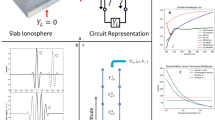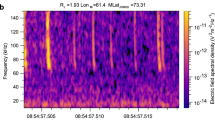Abstract
Satellite1 and rocket2 observations of high-energy electrons precipitated from the magnetosphere associated with lightning have focused new attention on mechanisms for coupling energy to the ionosphere and magnetosphere, particularly because such events are observed in the daytime when the propagation of radio waves through the ionosphere is very difficult because of losses in the ionospheric D-region due to enhanced electrical conductivity. Electric field measurements3,4 have indicated electrical pulses in the ionosphere following lightning strokes which are much longer in duration than predicted by electromagnetic radiation or 'relaxation time' theories. These fields can be studied theoretically using the decay of charge 'monopoles' injected into the atmospheric conductivity profile by the lightning currents. We derive here a simple analytical expression for calculating the total current waveform to the ionosphere after a lightning stroke. The validity of this expression is demonstrated by comparison with a more rigorous computer solution of Maxwell's equations. The analytic model demonstrates that the temporal variation of the current induced in the ionosphere and global circuit and the corresponding return current in the earth depends on the conductivity profile at intervening altitudes in the middle atmosphere. A conclusion is that capaci-tive coupling may provide tighter coupling between the lower atmosphere and the ionosphere than usually considered, in both directions, which may help to explain observations which seem to indicate that magnetospheric phenomena may in some instances trigger lightning5,17.
This is a preview of subscription content, access via your institution
Access options
Subscribe to this journal
Receive 51 print issues and online access
$199.00 per year
only $3.90 per issue
Buy this article
- Purchase on Springer Link
- Instant access to full article PDF
Prices may be subject to local taxes which are calculated during checkout
Similar content being viewed by others
References
Voss, H. D. et al. Nature 312, 740–745 (1984).
Goldberg, R. A., Barcus, J. R., Hale, L. C. & Curtis, S. A. J. atmos. terr. Phys. 48, 293–300 (1986).
Hale, L. C. in Weather and Climate Responses to Solar Variations (ed. McCormac, B. M.) 311–321 (Colorado Associated University Press, 1983).
Kelley, M. C. et al. J. geophys. Res. 90, 9815–9823 (1985).
Armstrong, W. C. Nature 327, 405–407 (1987).
Wilson, C. T. R. Proc. R. Soc. A 92, 555–574 (1916).
Tamura, Y., J. Geomagn. Geoelect., Kyoto 6, 34–46 (1954).
Illingworth, A. J. J. R. meteorol. Soc. 98, 604–615 (1972).
Dejnakarintra, M. & Park, C. G. J. geophys. Res. 79, 1903–1914 (1974).
Greifinger, C. & Greifinger, P. J. geophys. Res. 81, 2237–2247 (1976).
Holtzworth, R. H. & Chiu, Y. T. in Handbook of Atmospherics, Vol. 2 (ed. Volland, H.) 1–20 (CRC, Baton Rouge, 1982).
Fong, C. Y. & Kittel, C. Am. J. Phys. 35, 1091–1093 (1967).
Baginski, M. E. thesis, Penn. State Univ. (1987).
Krider, E. P. & Musser, J. A. J. geophys. Res. 87, 171–173 (1982).
Sunde, E. D. in Earth Conduction Effects in Transmission Systems (Dover, New York, 1968).
Nisbet, J. S. J. geophys. Res., 90, 9831–9844 (1986).
Hale, L. C. Nature. 329, 769 (1987).
Author information
Authors and Affiliations
Rights and permissions
About this article
Cite this article
Hale, L., Baginski, M. Current to the ionosphere following a lightning stroke. Nature 329, 814–816 (1987). https://doi.org/10.1038/329814a0
Received:
Accepted:
Issue Date:
DOI: https://doi.org/10.1038/329814a0
This article is cited by
-
Thunderstorms, Lightning, Sprites and Magnetospheric Whistler-Mode Radio Waves
Surveys in Geophysics (2008)
-
Electric fields from model lightning discharges in a neutral atmosphere
Radiophysics and Quantum Electronics (1998)
-
Lightning triggering and synchronization
Nature (1987)
Comments
By submitting a comment you agree to abide by our Terms and Community Guidelines. If you find something abusive or that does not comply with our terms or guidelines please flag it as inappropriate.



